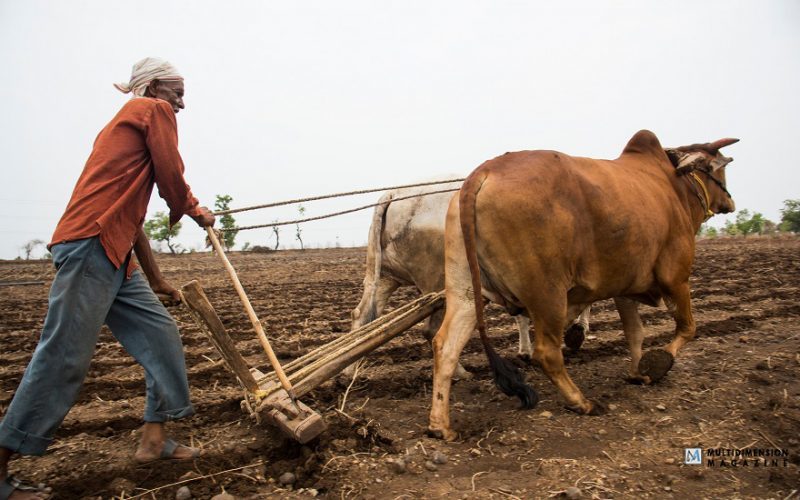Written by : Srijan Das
Photo : shutterstock.com
While India’s GDP contracts 23.9% in April-June quarter due to lockdown and linked to negative effects from some of the economic policies adopted in past years, the manufacturing sector recorded a drop of 39.3 percent from a growth of 3 percent last year and the mining sector shrank by 23.3 percent from a growth of 4.7 percent last year, whereas the agriculture sector stood out as a beacon of hope growing 3.4 percent in the first quarter of 2020-21 from 3 percent last year.
Initiating a process of introspection
With each passing year, the agrarian crisis in India worsens. Several factors have contributed to the corrosion of India’s agriculture system, but for the most part, India’s ever-expanding exposure to the free markets, along with the government’s imposition of neo-liberal policies to fill their coffers have had the most substantial impact. The strategy of selling off mineral-rich lands and forested areas to giant corporations has also created a number of issues for peasants in the largely agrarian South Asian nation. In 1991, the year of the Dissolution of the Soviet Union, India opened its economy to free markets, marking a pivotal moment for India’s agriculture industry. The market emerged as the central actor governing economic activity during the 1990s, and the ethos of neoliberalism progressively entrenched itself into law and public institutions in India. This change in “policy paradigms” implies a substantial reorganization of domestic political economies for an efficient governance of political and economic institutions in a longer run.
Since 1995, four years after India opened its doors to free markets, according to India’s National Crime Records Bureau (NCRB), nearly 270,000 Indian cotton farmers have killed themselves. The ‘Accidental Deaths & Suicides in India,’ has placed the death toll for a cumulative 16-year at 256,913 deaths, the worst-ever recorded wave of suicides of this kind in human history.
There may be various reasons for the farmers’ suicides but the most important one seems to be the very high levels of indebtedness; indebtedness of the kind which became unviable where farmers were reduced to a situation in which they sold land, had no collateral to pledge, were unable to think of paying the interest on the loans leave alone any part of the principal. The question is why should there have been this phenomenon leading to high indebtedness particularly since 1988. Obviously, it is not really the long-term problem of a high degree of concentration of land and other assets or that there are very large numbers of poor, marginal and landless farmers. Those long-term factors are not what we have to look out for. We have to look at much more specific factors which have come into existence just during the economic reforms period.
And the major factors have been twofold. If we look at it from the side of input costs, we find that economic reform policies have led to a phenomenal rise in input costs. Fertilizer subsidies have been removed – the supply of fertilizers has been handed over to private agents and the government has withdrawn from this. Secondly, the cost of credit has increased enormously after the implementation of the Narasimham Committee report. The treatment of agriculture and the small-scale industry as priority sectors for lending at low cost interest rates from the banking system has been given up. Perforce, farmers have been forced to turn more and more to private moneylenders who obviously charge high rates of interest and are much more inflexible in rolling over of debts than an institutional lender would be. On the side of material inputs, and on the side of credit, there has been a very sharp squeeze on the farmer with sharply rising input costs.
On the output side, trade liberalisation played a role. In the 1990s, global prices of commercial crops, including rubber and cotton, were rising. In response to that, since the government’s policy also was to increase exports from the agriculture sector as far as possible, unregulated export of raw cotton was allowed. If we look at the three years before 1990-1991, then 34,000 tonnes of raw cotton were being exported. The moment this sector was opened up, in a single year there was a jump of 3,74,000 tonnes in the export of raw cotton – more than a tenfold jump in a single year. This has been fluctuating but on the average for the three or four post-reform years it has been over two lakh tonnes. So, obviously, when we have a very sudden export surge like that and with output not increasing that fast, the raw cotton crisis trebled. It affected the handloom weavers because yarn prices also trebled.
This was the period from roughly 1990 to 1995-1996 when many thousands of farmers, in fact lakhs of small farmers, were switching from food crops to cotton as the world prices were rising. Many of them had not cultivated cotton before. This has been established by various research studies carried out, where the families of the suicide victims admitted to not having traditionally cultivated the crop before. They said that they had gone for cotton cultivation expecting high profits. There was this sudden expansion of area under cotton these farmers could not afford to do so except on the basis of credit. They took loans and the amount of loans they took to produce cotton was much higher than they had taken in the past, as they would have grown rain-fed food crops on the same land, which would not have cost much for production. So the switch to an exportable commercial crop led to a scenario of rising indebtedness. But at that time, people were very hopeful. World prices were on the rise and they hoped that they would get output which they would be able to export at a good price and repay as well. And that was the expectation with which loans were rolled over and given year after year as well.
But when the government withdraws from pesticide and fertilizer supply and winds up extension services under the dogma of letting the free market have its sway, many fly-by-night operators come into the picture. No regulation or overseeing of the quality of the inputs has been taking place. But the real time that things started going wrong was when the output was not as expected. But, most importantly, the world prices started crashing from the end of 1996 onwards and by 2001 it was practically at half the level it was in 1995. So there was a scenario where farmers had gone in for a heavy level of indebtedness and had been forced to do so by private moneylenders at a high cost due to a withdrawal of low-cost institutional lending. At the same time, the input prices went up and output prices crashed. This is a readymade scenario for agrarian distress.
All these factors are directly related to economic reform policies and trade liberalisation. The government did not intervene with any valorisation programmes or with any programme of buying up cotton at a fair price from the farmers. It could have done so, but it was operating with the dogma of leaving everything to the free market. This went on year after year and the fall in prices became a prolonged phenomenon. From the end of 2001, prices started rising slightly but the rise is really nothing compared to the earlier fall. And creditors started foreclosing on the debts. How does a farmer, heavily indebted, deal with this? First, he will sell off all his collaterals, he will borrow more from another moneylender to pay off the first loan, but if his crop is pest-affected, his credit-worthiness also comes down. So, in a sense, many farmers have found themselves at the end of their tether
Also the land grab is at the heart of the issues afflicting the farmers and Indigenous communities in India. According to government figures, at 1.15 hectare, the average farm size in India is small, and since 1970-71, there has been a steady declining trend in land holdings. The small and marginal land holdings (less than 2 hectares) account for 72 percent of land holdings, and this predominance of small operational holdings is a major limitation to reaping the benefits of economies of scale. Because of this, the small and marginal farmers have the little marketable surplus and are left with low bargaining power and no say over the prices.
In March of 2018, for weeks, tens of thousands of Indian farmers rallied, under the red flag, meeting in several cities to list their agenda and demands for the government to implement peasant-friendly policies as part of broader agrarian reform. With farmers demanding “freedom from debt and remunerative price,” through these ongoing massive protests, until the land reform favoring these farmers is not implemented, they will not be genuinely liberated of the cyclical issues of crop production, and the issues like weather and disaster, price, credit, market, and policy will continue to play with their lives.
A strategy of statistics and missing transparency
According to the latest National Crime Records Bureau (NCRB) data on accidental deaths and suicides, 10,281 farmers committed suicide in 2019, the numbered fell marginally from 10,357 in 2018, whereas the figure for daily wagers went up to 32,559 from 30,132, a significant increase of 8 per cent.
In 2015, the NCRB had published elaborate data on farmer suicides, including the reasons for suicides. However, the report released by the bureau on Monday omitted these classifications and instead gave a break-up in terms of males and females
A comparative study of data on Accidental Deaths and Suicides released by NCRB shows that suicides in the agriculture sector have declined by 10% — from 11,379 in 2016 to 10,281 in 2019.
When cultivators and farm labour are taken separately, there is a much steeper decline in suicides among the latter. According to the data, while suicides among cultivators (landowners and those cultivating on lease) declined by 5 per cent, suicides among farm hands declined by 15%.
We should remark that the NCRB has released data for the years 2017, 2018 and 2019 together. The data for 2017 and 2018 had been inordinately delayed. The last NCRB report — of the year 2016 — on farmer suicides was released in November 2019.
An application under the Right to Information (RTI) act, filed by Ms.Meena Menon on 12.12.2018, demanding farmers’ suicides data for the whole country from 2016 to 2018 (three years) and the reasons for not making them public, elicited the response that the data for accidental deaths and suicides for 2016 is under finalisation. In a reply dated 8 January 2019, senior statistical officer Sanjay Kumar said that the data for 2017 and 2018 is not with the Bureau as yet. He then went on to give navigational details of how to access the 2015 data and the general information available on the website.
Finally in its last report, the NCRB has done away with causes of farmer suicides, which included reasons such as “crop failure” and “loans”.
About the central government policies
On the occasion of Balaram Jayanti, August 9, 2020, the Prime Minister Narendra Modi released the sixth instalment of financing facility under PM-KISAN scheme (Pradhan Mantri Kishan Samman Nidhi) via video conferencing. According to the declaration, 17,000 crore rupees has been deposited into the bank accounts of 8.5 crore farmers with a single click. The fund has been initiated to boost the earnings of farmers and make them self-reliant under the PM’s clarion of Atma-Nirbhar Abhiyan came in effect from December 2018. The government is providing annually 6,000 rupees in three equal installments to 14 crore farmers.
The government claims to have provided over 75,000 crore rupees cash benefit to more than 9.9 crore farmers as part of the scheme since its adoption.
The Prime Minister also said that farmers are now exempted from the purview of the mandi and the mandi tax, and informed that the government will allot 1 lakh crore rupees for the Agricultural Infrastructure Fund, a financing facility provided under the new Central Sector scheme for fiscal years 2020 – 2029.
(End of part one)
Farmers Suicide in India – A Continuum of Neo-Liberal Policies : Part-2
About the author :
Srijan Das : Student, Indian Statistical Institute, Kolkata




